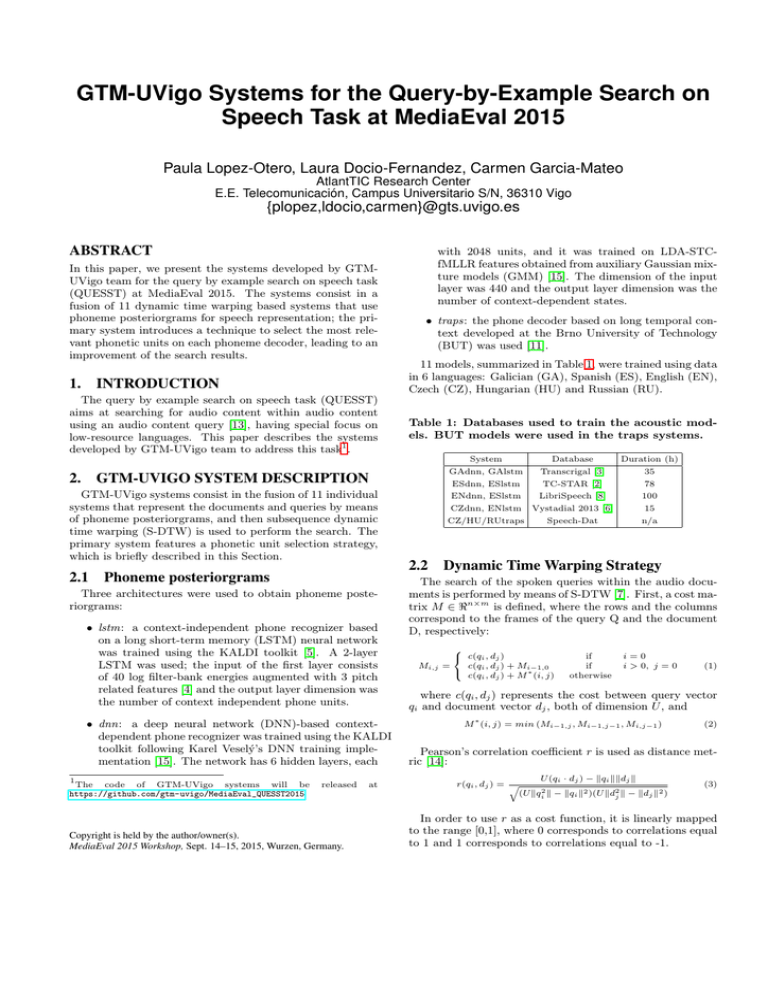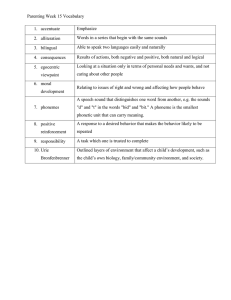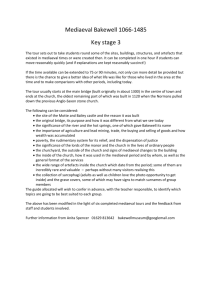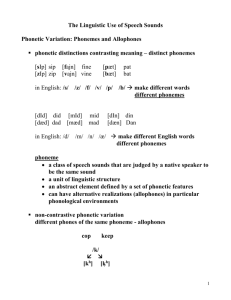GTM-UVigo Systems for the Query-by-Example - CEUR
advertisement

GTM-UVigo Systems for the Query-by-Example Search on
Speech Task at MediaEval 2015
Paula Lopez-Otero, Laura Docio-Fernandez, Carmen Garcia-Mateo
AtlantTIC Research Center
E.E. Telecomunicación, Campus Universitario S/N, 36310 Vigo
{plopez,ldocio,carmen}@gts.uvigo.es
ABSTRACT
In this paper, we present the systems developed by GTMUVigo team for the query by example search on speech task
(QUESST) at MediaEval 2015. The systems consist in a
fusion of 11 dynamic time warping based systems that use
phoneme posteriorgrams for speech representation; the primary system introduces a technique to select the most relevant phonetic units on each phoneme decoder, leading to an
improvement of the search results.
1. INTRODUCTION
The query by example search on speech task (QUESST)
aims at searching for audio content within audio content
using an audio content query [13], having special focus on
low-resource languages. This paper describes the systems
developed by GTM-UVigo team to address this task1 .
with 2048 units, and it was trained on LDA-STCfMLLR features obtained from auxiliary Gaussian mixture models (GMM) [15]. The dimension of the input
layer was 440 and the output layer dimension was the
number of context-dependent states.
• traps: the phone decoder based on long temporal context developed at the Brno University of Technology
(BUT) was used [11].
11 models, summarized in Table 1, were trained using data
in 6 languages: Galician (GA), Spanish (ES), English (EN),
Czech (CZ), Hungarian (HU) and Russian (RU).
Table 1: Databases used to train the acoustic models. BUT models were used in the traps systems.
System
2. GTM-UVIGO SYSTEM DESCRIPTION
GTM-UVigo systems consist in the fusion of 11 individual
systems that represent the documents and queries by means
of phoneme posteriorgrams, and then subsequence dynamic
time warping (S-DTW) is used to perform the search. The
primary system features a phonetic unit selection strategy,
which is briefly described in this Section.
2.1 Phoneme posteriorgrams
Three architectures were used to obtain phoneme posteriorgrams:
• lstm: a context-independent phone recognizer based
on a long short-term memory (LSTM) neural network
was trained using the KALDI toolkit [5]. A 2-layer
LSTM was used; the input of the first layer consists
of 40 log filter-bank energies augmented with 3 pitch
related features [4] and the output layer dimension was
the number of context independent phone units.
• dnn: a deep neural network (DNN)-based contextdependent phone recognizer was trained using the KALDI
toolkit following Karel Veselý’s DNN training implementation [15]. The network has 6 hidden layers, each
1
The code of GTM-UVigo systems will be
https://github.com/gtm-uvigo/MediaEval_QUESST2015
released
Copyright is held by the author/owner(s).
MediaEval 2015 Workshop, Sept. 14–15, 2015, Wurzen, Germany.
at
Database
GAdnn, GAlstm
Transcrigal [3]
ESdnn, ESlstm
TC-STAR [2]
ENdnn, ESlstm
LibriSpeech [8]
CZdnn, ENlstm Vystadial 2013 [6]
CZ/HU/RUtraps
Speech-Dat
2.2
Duration (h)
35
78
100
15
n/a
Dynamic Time Warping Strategy
The search of the spoken queries within the audio documents is performed by means of S-DTW [7]. First, a cost matrix M ∈ ℜn×m is defined, where the rows and the columns
correspond to the frames of the query Q and the document
D, respectively:
Mi,j =
c(qi , dj )
c(qi , dj ) + Mi−1,0
c(q , d ) + M ∗ (i, j)
i
j
if
if
otherwise
i=0
i > 0, j = 0
(1)
where c(qi , dj ) represents the cost between query vector
qi and document vector dj , both of dimension U , and
∗
M (i, j) = min (Mi−1,j , Mi−1,j−1 , Mi,j−1 )
(2)
Pearson’s correlation coefficient r is used as distance metric [14]:
U (qi · dj ) − kqi kkdj k
r(qi , dj ) = q
(U kqi2 k − kqi k2 )(U kd2j k − kdj k2 )
(3)
In order to use r as a cost function, it is linearly mapped
to the range [0,1], where 0 corresponds to correlations equal
to 1 and 1 corresponds to correlations equal to -1.
Table 2: Performance of systems submitted by GTM-UVigo team.
Dev
System
Metric
All
T1
Eval
T2
T3
All
T1
Dev-late
T2
T3
All
T1
T2
Eval-late
T3
All
T1
T2
T3
Primary
actCnxe
0.917 0.881 0.943 0.918 0.919 0.864 0.959 0.913 0.875 0.841 0.890 0.882 0.871 0.815 0.916 0.866
minCnxe 0.905 0.861 0.928 0.904 0.905 0.844 0.946 0.882 0.847 0.788 0.865 0.860 0.838 0.758 0.895 0.824
lowerbound 0.627 0.562 0.672 0.631 0.629 0.532 0.702 0.627 0.593 0.526 0.633 0.606 0.592 0.490 0.657 0.601
Contrastive
actCnxe
0.998 0.998 0.997 1.000 0.999 0.999 0.997 1.000 0.907 0.897 0.916 0.904 0.898 0.852 0.933 0.896
minCnxe 0.918 0.874 0.942 0.898 0.923 0.865 0.953 0.907 0.864 0.811 0.877 0.880 0.852 0.785 0.900 0.843
lowerbound 0.635 0.588 0.681 0.627 0.633 0.555 0.693 0.624 0.618 0.559 0.655 0.633 0.613 0.521 0.669 0.622
In order to detect nc candidate matches of a query in a
spoken document, every time a candidate match is detected,
which ends at frame b∗ , M (n, b∗ ) is set to ∞ in order to
ignore this match.
2.3 Phoneme Unit Selection
A technique to select the most relevant phonemes among
the phonetic units of the different decoders was used in the
primary system. Given the best alignment path P(Q,D) of
length K between a query and a matching document, the
correlation and the cost at each step of the path can be
decomposed so there is a different term for each phonetic
unit u:
r(qi , dj , u) = q
U qi,u dj,u −
(U kqi2 k
−
1
U
kqi kkdj k
kqi k2 )(U kd2j k
− kdj
K
1 X
c(qik , djk , u)
K k=1
Table 3: actCnxe of some individual systems with
and without applying phoneme unit selection.
With
(5)
This value R(P (Q, D), u) can be considered as the relevance of the phonetic unit u (the lower the contribution to
the cost, the more relevant the phonetic unit). Hence, the
phonetic units can be sorted from more relevant to less relevant in order to keep the most relevant ones and to discard
those who increased the cost of the best alignment path.
Using only one alignment path may not provide a good
estimate of the relevance of the phonetic units; hence, the
relevance of the different pairs query-matching document in
the development set were accumulated in order to robustly
estimate the relevance. The number of relevant phonetic
units was empirically selected for each system.
2.4 Normalization and fusion
Score normalization and fusion were performed following
[12]. First, the scores were normalized by the length of the
warping path. A binary logistic regression was used for fusion, as described in [1].
3. RESULTS AND DISCUSSION
Table 2 shows the results obtained on QUESST 2015 data
using the submitted systems. The Table shows that the primary system, that features phoneme unit selection, clearly
outperforms the contrastive system, suggesting that the proposed technique obtains the expected improvement. Another fact that can be observed is that Dev and Eval results
are very similar, showing the generalization capability of the
T1
Without
System
Global
T2
T3
Global
CZdnn
0.889
0.829 0.902 0.906
0.915
0.867 0.927 0.922
T1
T2
T3
CZlstm
0.902
0.864 0.922 0.901
0.907
0.864 0.932 0.904
CZtraps
0.902
0.840 0.924 0.910
0.931
0.883 0.945 0.938
HUtraps
0.903
0.856 0.926 0.899
0.934
0.894 0.950 0.936
RUtraps
0.895
0.844 0.918 0.894
0.925
0.886 0.944 0.922
(4)
k2 )
In this way, the cost accumulated by each phonetic unit
through the best alignment path can be computed:
R(P (Q, D), u) =
systems. Late systems feature z-norm normalization of the
query scores, obtaining an improvement with respect to the
original submissions, where only path-length normalization
was applied. In Table 3, actCnxe obtained with and without applying the phoneme unit selection approach in some
individual systems are compared.
Table 4 shows the indexing speed factor (ISF), searching
speed factor (SSF), peak memory usage for indexing (PMUI )
and searching (PMUS ) and processing load (PL)2 , computed
as described in [9]. ISF and PMUI are rather high because,
in the dnn systems, first an automatic speech recognition
system (ASR) is applied in order to obtain the input features to the DNN; hence, the peak memory usage is so large
due to the memory requirements of the language model, and
the large computation time is caused by the two recognition
steps that are performed to estimate the transformation matrix used to obtain the fMLLR features that are the input
to the DNN. In future work, the ASR step of dnn systems
will be replaced with a phonetic network in order to avoid
these time and memory consuming steps.
Table 4: Required amount of processing resources.
ISF SSF PMUI PMUS PL
12.1 0.09
4.
6
0.014
7.3
ACKNOWLEDGEMENTS
This research was funded by the Spanish Government
(‘SpeechTech4All Project’ TEC2012-38939-C03-01), the Galician Government through the research contract GRC2014/024
(Modalidade: Grupos de Referencia Competitiva 2014) and
‘AtlantTIC Project’ CN2012/160, and also by the Spanish
Government and the European Regional Development Fund
(ERDF) under project TACTICA.
2
These values were computed using 2xIntel(R) Xeon(R) CPU E5-2620
v3 @ 2.40GHz, 12cores/24threads, 128GB RAM.
5. REFERENCES
[1] M. Akbacak, L. Burget, W. Weng, and J. Houtvan.
Rich system combination for keyword spotting in
noisy and acoustically heterogeneous audio streams. In
Proceedings of ICASSP, pages 8267–8271, 2013.
[2] L. Docio-Fernandez, A. Cardenal-Lopez, and
C. Garcia-Mateo. TC-STAR 2006 automatic speech
recognition evaluation: The UVIGO system. In
TC-STAR Workshop on Speech-to-Speech Translation,
2006.
[3] C. Garcia-Mateo, J. Dieguez-Tirado,
L. Docio-Fernandez, and A. Cardenal-Lopez.
Transcrigal: A bilingual system for automatic
indexing of broadcast news. In Proceedings of the
Fourth International Conference on Language
Resources and Evaluation (LREC), 2004.
[4] P. Ghahremani, B. BabaAli, D. Povey,
K. Riedhammer, J. Trmal, and S. Khudanpur. A pitch
extraction algorithm tuned for automatic speech
recognition. In IEEE International Conference on
Acoustics, Speech and Signal Processing, ICASSP
2014, Florence, Italy, May 4-9, 2014, pages
2494–2498, 2014.
[5] A. Graves, A. Mohamed, and G. E. Hinton. Speech
recognition with deep recurrent neural networks. In
IEEE International Conference on Acoustics, Speech
and Signal Processing, ICASSP 2013, Vancouver, BC,
Canada, May 26-31, 2013, pages 6645–6649, 2013.
[6] M. Korvas, O. Plátek, O. Dušek, L. Žilka, and
F. Jurčı́ček. Vystadial 2013 - Czech data, 2014.
LINDAT/CLARIN digital library at Institute of
Formal and Applied Linguistics, Charles University in
Prague.
[7] M. Müller. Information Retrieval for Music and
Motion. Springer-Verlag, 2007.
[8] V. Panayotov, G. Chen, D. Povey, and S. Khudanpur.
LibriSpeech: an ASR corpus based on public domain
audio books. In Proceedings of ICASSP, pages 99–105,
2015.
[9] L. Rodriguez-Fuentes and M. Penagarikano.
MediaEval 2013 spoken web search task: system
performance measures. Technical report, Dept.
Electricity and Electronics, University of the Basque
Country, 2013.
[10] L. Rodriguez-Fuentes, A. Varona, M. Penagarikano,
G. Bordel, and M. Diez. GTTS systems for the SWS
task at MediaEval 2013. In Proceedings of the
MediaEval 2013 Workshop, 2013.
[11] P. Schwarz. Phoneme Recognition based on Long
Temporal Context. PhD thesis, Brno University of
Technology, 2009.
[12] I. Szöke, L. Burget, F. Grézl, J. Černocký, and
L. Ondel. Calibration and fusion of query-by-example
systems - BUT SWS 2013. In Proceedings of ICASSP
2014, pages 7899–7903. IEEE Signal Processing
Society, 2014.
[13] I. Szöke, L. Rodriguez-Fuentes, A. Buzo, X. Anguera,
F. Metze, J. Proenca, M. Lojka, and X. Xiong. Query
by example search on speech at Mediaeval 2015. In
Proceedings of the MediaEval 2015 Workshop, 2015.
[14] I. Szöke, M. Skácel, and L. Burget. BUT
QUESST2014 system description. In Proceedings of
the MediaEval 2014 Workshop, 2014.
[15] K. Veselý, A. Ghoshal, L. Burget, and D. Povey.
Sequence-discriminative training of deep neural
networks. In INTERSPEECH 2013, 14th Annual
Conference of the International Speech
Communication Association, Lyon, France, August
25-29, 2013, pages 2345–2349, 2013.






